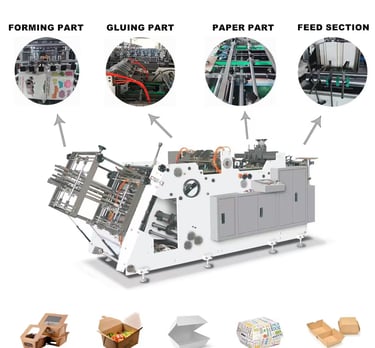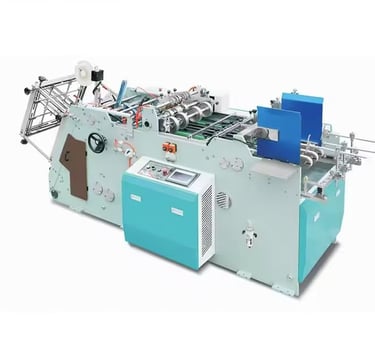The Ultimate Guide to Paper Production: Machines, Technology, and Trends
LEON MACHINERY
2/19/20255 min read


Introduction: The Growing Demand for Paper Products
In a world where digital solutions continue to dominate, paper remains a crucial commodity in many industries. Whether it's for hygiene, packaging, or industrial purposes, paper products are woven into the fabric of daily life. From the tissues we use every day to the packaging materials that protect goods, the demand for paper products is ever-growing.
But behind every soft tissue, robust box, or neatly cut napkin, there's an intricate process of manufacturing and precision engineering. The machinery that drives the paper production process is as varied as the products it creates. From paper tissue production lines to advanced packing machines, each step involves state-of-the-art technology designed to meet the needs of modern consumers.
In this blog, we'll dive deep into the different categories of paper production and explore the machines that make it all possible. If you’ve ever wondered about the process behind your favorite tissue products or packaging solutions, this is the ultimate guide for you.
The Paper Tissue Production Line: Revolutionizing Hygiene Products
At the heart of paper tissue production lies the tissue production line. This process involves the transformation of raw paper pulp into various types of tissues used in homes and businesses around the world. The paper tissue production line includes machines designed to produce high-quality tissues for different uses: from facial tissues to napkins and toilet paper.
The key components of a tissue production line include pulping equipment, a tissue-making machine, and a drying system. The raw pulp is transformed into a thin sheet, which is then pressed, dried, and cut into the desired size. In today’s competitive market, manufacturers are seeking machines that are not only efficient but also energy-efficient, reducing their environmental footprint while maintaining high output levels.
The Paper Making Machine: A Backbone of the Industry
Without a doubt, the paper-making machine is the backbone of the entire paper production industry. It is the machinery that turns raw materials into usable paper for a myriad of applications. These machines can produce everything from thin sheets for printing to heavy-duty paper used in packaging.
Modern paper-making machines use a combination of advanced techniques such as pressing, drying, and calendaring. Through the pressing process, the paper is compacted, removing excess moisture and preparing it for the drying stage. The drying process ensures the paper reaches the required thickness and texture. And as paper quality continues to improve, technology plays an integral role in ensuring precise measurements and consistent results.
The Paper Packing Machine: Ensuring Quality Packaging
Once the paper is manufactured, it's time to pack it for distribution. The paper packing machine is the unsung hero of the paper industry, ensuring that every paper product, whether it’s a roll of toilet paper or a pack of napkins, is securely packaged for retail.
Paper packing machines are designed to automate the packaging process, reducing labor costs and ensuring each product is wrapped with precision. With features such as automatic wrapping, sealing, and labeling, these machines make it easier for manufacturers to produce large quantities of paper products while maintaining high standards of packaging quality.
As the demand for eco-friendly packaging solutions rises, manufacturers are investing in advanced paper packing machines that use biodegradable materials, offering a more sustainable solution to traditional plastic packaging.
The Paper Cutting Machine: Precision Meets Efficiency
In the paper production process, precision is key. And when it comes to cutting paper, machines are designed to perform with pinpoint accuracy. The paper cutting machine ensures that every sheet is cut to size and shape, with minimal waste and maximum efficiency.
There are various types of paper cutting machines available, including guillotine cutters, rotary cutters, and laser cutters. Each of these machines serves a specific purpose, depending on the type of paper being cut and the volume of production. Today, many paper cutting machines come with advanced features such as automatic paper feeding, programmable cutting lengths, and even integration with other paper production systems to streamline operations.
The future of paper cutting machines lies in automation, with smarter systems that reduce human error and improve operational efficiency. The result is not just better quality products, but also faster production times and lower costs.
Specialized Machines: From Paper Tubes to Napkins
The versatility of paper extends beyond just sheets and rolls. Specialized machines have been developed to produce everything from paper tubes and straws to napkins, facial tissues, and hand towels. Here are some of the standout machines in this category:
Paper Tube/Straw Making Machine: These machines are designed to create paper tubes or straws used in a variety of industries. From food packaging to straws for beverages, these machines offer precision and durability for mass production.
Toilet Tissue Making Machine: Toilet paper is one of the most commonly used paper products, and the machines that make it are designed to produce large quantities efficiently. These machines turn raw pulp into soft, absorbent toilet tissue, ready for use in homes and businesses.
Napkin Tissue Making Machine: Similar to toilet tissue machines, napkin tissue machines specialize in creating high-quality napkins for use in restaurants, hotels, and households. They ensure that each napkin is uniformly produced with minimal defects.
Facial Tissue Making Machine: Facial tissues are a delicate product, requiring careful handling. These machines are designed to produce soft, high-quality facial tissues, often incorporating advanced features like embossing and printing.
Hand Towel Paper Machine: Hand towels are essential in both public and private spaces. The hand towel paper machine produces thick, absorbent towels for various purposes, from industrial settings to bathrooms in homes.
Pocket Tissue Making Machine: Small, portable tissues that fit in your pocket are produced by these specialized machines. They are designed to create smaller packs of tissues that are convenient for on-the-go use.
Packaging Paper Products: The Final Touch
After paper products are manufactured, they need to be packed and sealed for distribution. The packaging process is an essential step in ensuring the products reach consumers in good condition.
Different types of packing machines are used depending on the product. For example, toilet tissue roll packing machines are designed to wrap toilet paper in protective packaging. Similarly, napkin tissue packing machines, facial tissue packing machines, and pocket tissue packing machines are all tailored to meet the specific requirements of each paper product.
These machines can pack products in bulk or individual units, and the packaging is often customized to include branding and product details. As sustainability becomes more important, manufacturers are incorporating eco-friendly packaging options, such as recyclable materials, into their production processes.
The Future of Paper Production: Trends to Watch
The paper production industry is evolving rapidly, driven by technological advancements and a growing focus on sustainability. Here are some trends to watch in the future:
Sustainability and Eco-Friendly Solutions: As consumers and businesses alike seek more sustainable products, the paper industry is embracing greener practices. From reducing water and energy consumption to using recycled materials, the future of paper production lies in creating environmentally friendly solutions.
Automation and Smart Technology: Automation continues to revolutionize the paper industry. With advancements in robotics, AI, and machine learning, manufacturers can increase production efficiency, reduce waste, and ensure higher quality control.
Growth Areas: Emerging markets in developing countries are driving the growth of the paper industry. As these regions see increased urbanization and a rise in disposable income, the demand for paper products is expected to grow, providing new opportunities for manufacturers.
Conclusion: Embracing Efficiency and Quality
The paper production industry is vast and dynamic, with machines and technologies that play an integral role in creating the paper products we use every day. From tissue production lines to specialized packing machines, the industry continues to evolve, embracing new technologies, sustainability practices, and consumer demands.
As manufacturers continue to innovate and refine their processes, the future of paper production looks brighter than ever. Whether you’re in the market for a high-end paper-making machine or a specialized packing solution, understanding the technology behind the process will help you make informed decisions that benefit both your business and the environment.


